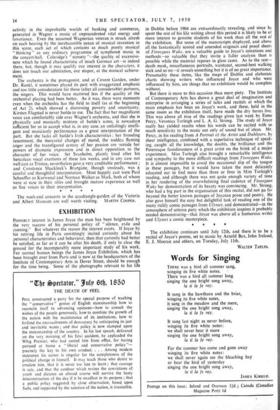EXHIBITION
POSSIBLY interest in James Joyce the man has been heightened by the very success of his personal policy of " silence, exile and cunning." But whatever the reason the interest exists. If Joyce by his retiring life in Paris unwittingly incited curiosity about his personal characteristics and behaviour, then that curiosity had better be satisfied, as far as it can be after his death, if only to clear the ground for the incomparably more important study of his work. For normal human beings the James Joyce Exhibition, which has been brought over from Paris and is now at the headquarters of the Institute of Contemporary Arts in Dover Street, should be enough for the time being. Some of the photographs relevant to his life
in Dublin before 1904 are extraordinarily revealing, and since he spent the rest of his life writing about this period it is likely to be of more interest to genuine students of his work than all the rest of the exhibition. But some of the manuscripts displayed, and above all the fantastically scored and amended originals and proof sheets of Finnegans Wake, are a valuable guide to Joyce's intentions and methods—so valuable that they invite a fuller analysis than is possible while the material reposes in glass cases. As to the rest— death mask, miscellaneous portraits, waistcoat, second-best walking stick and so on—it reveals something but it is of no great importance. Presumably these items, like the maps of Dublin and elaborate charts showing writers who influenced Joyce and who were influenced by him, are things that no exhibition would be complete without.
But there is more to this occasion than mere piety. The Institute of Contemporary Arts has shown a great deal of imagination and enterprise in arranging a series of talks and recitals at which the main emphasis has been on Joyce's work, and these, held in the same room as the exhibition itself, have made the dry bones live. This was above all true of the readings given last week by Esme Percy, Veronica Turleigh and L. A. G. Strong. The study of Joyce really has yielded results when his words can be recited with so much sensitiyity to the music not only of sound but of ideas. Mr. Percy, in his reading from A Portrait of the Artist and Dubliners, by sheer intelligence, combined with a superlative technique of speak- ing, caught all the knowledge, the doubts, the brilliance and the Pateresque fastidiousness of a great artist on the brink of a major experiment. Miss Turleigh also brought a remarkable intelligence and sympathy to the more difficult readings from Finnegans Wake. It is almost impossible to avoid the occasional slip of the tongue in these passages, but it would have taken the most delicately educated ear to find more than three or four in Miss Turleigh's reading, and although there was not quite enough variety of tone in her rendering of the overwhelming final cadence of Finnegans Wake her demonstration of its beauty was convincing. Mr. Strong, who had a big part in the organisation of this recital, did not go far beyond the better known passages of Joycean prose and poetry. He also gave himself the easy but delightful task of reading one of the many richly comic passages from Ulysses, and demonstrated—in the atmosphere of solemn piety which the exhibition inspires it probably needed demonstrating—that Joyce was above all a humorous writer and Ulysses a comic masterpiece.
* * * * The exhibition continues until July 12th, and there is to be a recital of Joyce's poems, set to music by Arnold Bair, John Ireland, E. J. Moeran and others, on Tuesday, July 11th.
WALTER TAPLIN.






































 Previous page
Previous page